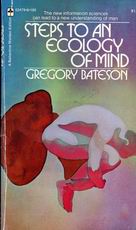
| Home News Releases | Calendar Contact |
Sources Bookshelf

Steps to an Ecology of Mind
Bateson, Gregory
Publisher: Ballantine Books, New York, USAYear Published: 1972
Pages: 517pp ISBN: 345-02479-6-195
-
Table of Contents
Preface, Mark Engel
Foreword
Introduction: The Science of Mind and Order
Part I: Metalogues
Metalogue: Why Do Things Get in a Muddle?
Metalogue: Why Do Frenchmen?
Metalogue: About Games and Being Serious
Metalogue: How Much Do You Know?
Metalogue: Why Do Things Have Outlines?
Metalogue: Why a Swan?
Metalogue: What Is an Instinct?
Part II: Form and Pattern in Anthropology
Culture Contact and Schismogenesis
Experiments in Thinking About Observed Ethnological Material
Morale and National Character
Bali: The Value System of a Steady State
Style, Grace, and Information in Primitive Art Comment on Part II
Part III: Form and Pathology in Relationship
Social Planning and the Concept of Deutero-Learning
A Theory of Play and Fantasy
Epidemiology of a Schizophrenia
Toward a Theory of Schizophrenia
The Group Dynamics of Schizophrenia
Minimal Requirements for a Theory of Schizophrenia
Double Bind, 1969
The Logical Categories of Learning and Communication
The Cybernetics of "Self": A Theory of Alcoholism
Comment on Part III
Part IV: Biology and Evolution
Illustrations for " A Re-examination of 'Bateson's Rule' "
The Roleof Somatic Change in Evolution
Problems in Cetacean and Other Mammalian Communication
A Re-examination of "Bateson's Rule"
Part V: Epistemology and Ecology
Cybernetic Explanation
Redundancy and Coding
Conscious Purpose Versus Nature
Effects of Conscious Purpose on Human Adaptation
Form, Substance, and Difference
Part VI: Crisis in the Ecology of Mind
From Versailles to Cybernetics
Pathologies of Epistemology
The Roots of Ecological Crisis
Ecology and Flexibility in Urban Civilization
The Published Work of Gregory Bateson
Subject Headings
© Sources 2023. The information provided is copyright and may not be reproduced in any form or by any means (whether electronic, mechanical or photographic), or stored in an electronic retrieval system, without written permission of the publisher.